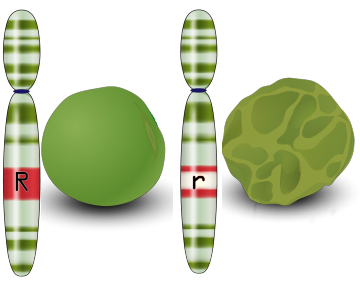Garden Pea Taste
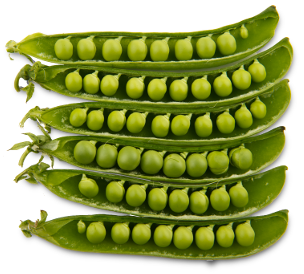 The common field pea (Pisum sativum) is one of the first plants to be domesticated as a crop, dating back to the Neolithic agricultural revolution, 10,000 BCE. It is the same species that Gregor Mendel, the founder of modern genetics, used in his experiments when he discovered the laws of genetic inheritance.
The common field pea (Pisum sativum) is one of the first plants to be domesticated as a crop, dating back to the Neolithic agricultural revolution, 10,000 BCE. It is the same species that Gregor Mendel, the founder of modern genetics, used in his experiments when he discovered the laws of genetic inheritance.
Wrinkled peas are sweeter than round peas because they contain more sugar and less starch. The increase in sugar content leads to more water retention causing the peas to wrinkle when they dry. This case will examine the evolution of the wrinkled pea from its ancestral round pea shape.
Mendel documented the presence and absence of different physical traits in pea plants in over 29,000 pea plants spanning many generations. The traits he focused on were flower color, seed shape, pod shape, pod color, flower position, stem length, embryo color.
Mendel’s Contribution
 Prior to Mendel, many thought that most traits of offspring must be a blended version of parental traits. Mendel showed that this is not necessarily the case and that offspring traits are determined by the combination of heritable units passed on by parents. We now call these heritable units for a particular characteristic, alleles.
Prior to Mendel, many thought that most traits of offspring must be a blended version of parental traits. Mendel showed that this is not necessarily the case and that offspring traits are determined by the combination of heritable units passed on by parents. We now call these heritable units for a particular characteristic, alleles.
In Pisum sativum, the characteristics that Mendel examined are each controlled by just one set of alleles. These alleles can combine in a homozygous (two copies of the same allele) or heterozygous (one copy of two different alleles) fashion depending on parental alleles. For example: The Yellow and Green pea trait is controlled by the alleles called Y and y. The Round and Wrinkled pea trait is controlled by the alleles called R and r. Alleles are, in a sense, different versions of a single characteristic.
Mendel suggested that inheritance of traits followed specific rules or laws:
The Law of Segregation
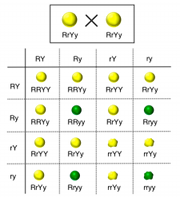 Each trait is linked to a pair of alleles that are passed down, one from each parent. A characteristic that is exhibited by the offspring will depend on which version of the characteristic is dominant and whether or not the offspring received one of these dominant alleles from one of its parents.
Each trait is linked to a pair of alleles that are passed down, one from each parent. A characteristic that is exhibited by the offspring will depend on which version of the characteristic is dominant and whether or not the offspring received one of these dominant alleles from one of its parents.
The Law of Independent Assortment
The inheritance of one characteristic is independent from the inheritance of another characteristic. For example, whether or not a pea plant has yellow or green seeds is independent of whether or not the pea plant has white or purple flowers. In other words, the presence or absence of a particular version of one characteristic (e.g. seed color) is not related to the presence or absence of a particular version of a different characteristic (e.g. flower color).
DNA, Central Dogma and the R Allele
DNA is made up of long strings of nucleotides. There are four nucleotides in DNA: Adenine (A), Thymine (T), Guanine (G) and Cytosine (C). These nucleotides are held together by a phosphate-sugar “backbone” and are complemented by a parallel strand of nucleotides making a DNA molecule “double-stranded”. Parallel strands are held together by hydrogen bonds between bases; Adenine binds to Thymine, Cytosine binds to Guanine. Discrete sections of DNA carry sequences of nucleotides that, when processed, are responsible for proteins or functional RNA chains. These sections are called genes. When making a protein, the DNA is first transcribed into a single-stranded piece of messenger RNA (mRNA) using an enzyme called RNA polymerase. The newly made mRNA is then translated through a ribosome into a long chain of amino acids. This chain of amino acids folds up to make a functional protein. Proteins build the organism, including all measurable and observable characteristics.
Amazingly, Mendel lived decades before the advent of microbiology and the discovery of genes, DNA, or chromosomes. He discovered the laws of inheritance without any basic understanding of the molecular basis of inheritance. We now know the characteristics that Mendel described correspond to specific genes within the pea plant genome. The “R” allele is a specific allele of the SBE1 gene that codes for a functional starch branching enzyme. This enzyme converts amylose starch to amylopectin starch within a pea seed. The “r” allele is a different variant of the SBE1 gene that codes for a non-functioning starch branching enzyme. Without a functional starch branching enzyme, amylopectin starch cannot be formed
Cell Biology
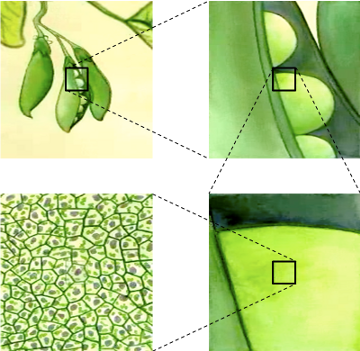 Although pea sweetness and pea shape may seem unrelated, they are not. While growing, sweeter peas accumulate higher water content because the sugar in them makes them hypertonic. As a result they draw more water into the seed. When they later dry out, the sweeter peas lose that extra water making them wrinkle. The starchy peas have more starch and comparatively little water so when they dry the high starch content keeps the shape round.
Although pea sweetness and pea shape may seem unrelated, they are not. While growing, sweeter peas accumulate higher water content because the sugar in them makes them hypertonic. As a result they draw more water into the seed. When they later dry out, the sweeter peas lose that extra water making them wrinkle. The starchy peas have more starch and comparatively little water so when they dry the high starch content keeps the shape round.
How to make sugar in a plant
In plants, the sugar glucose is one of the end products of photosynthesis. The processes of photosynthesis convert carbon dioxide and water to oxygen and three-carbon sugars, which subsequently are transformed into the six-carbon sugar, glucose. The light reactions of photosynthesis use the sun’s energy to split water into oxygen gas and hydrogen ions. By way of proton gradients and redox reactions, the hydrogen ions drive the production of chemical potential energy, in the form of ATP and NADPH, needed for the Calvin Cycle reactions. The Calvin Cycle reactions occur in three phases. In the first phase, carbon dioxide is incorporated into a five-carbon chain of sugar called ribulose bisphosphate (RuBP). This sugar is transformed into 3-phosphoglycerate. In the second phase of the Calvin Cycle, the chemical energy in ATP and NADPH is utilized to transform 3-phosphoglycerate into glyceraldehyde-3-phosphate or triose-phosphate*. This triose-phosphate goes through an additional five transformations to form ADP-glucose (see diagram). ADP-glucose is transformed into amylose starch by the starch synthetase enzyme; amylose is transformed into amylopectin starch by the starch branching enzyme.
Note: in the third phase of the Calvin Cycle triose-phosphate is converted back into RuBP. For the purpose of this case we are interested in what happens to the portion of triose-phosphate that takes a different pathway getting converted (eventually) into starch rather than completing the cycle back into RuBP. For more on the Calvin Cycle visit: http://en.wikipedia.org/wiki/Calvin_cycle.
How to make starch from sugar in a plant
Like sugar, there are multiple types of starch. The first type, amylose, is unbranched starch. It is a polysaccharide made up of between 300 and 3000 glucose subunits. It typically comprises around 20-30% of starch found in plants. The second type, amylopectin, is branched starch. It is a polysaccharide made up of between 2000 and 200000 glucose subunits. Branching occurs every 20-30 subunits. It typically comprises around 70-80% of the starch found in the seeds of plants. The conversion of amylose to amylopectin requires the use of a starch branching enzyme.
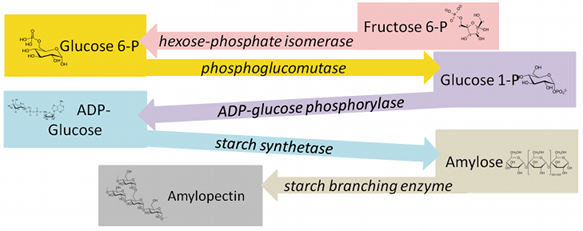
In wrinkled peas, the starch branching enzyme is generated from the r allele and is non-functional. This means that amylopectin cannot be produced, resulting in less total starch. Since less of the sugar is converted to starch there is excess simple sugar. Some of this sugar, Glucose 1-P is converted into UDP-Glucose which, when combined with Fructose 6-P, forms sucrose.
Molecular Genetics
The round seed phenotype is derived from the R allele of the SBE1 gene in Pisum sativum pea plants. This allele codes for a functional starch branching enzyme that converts amylose into amylopectin. Conversely, the wrinkled seed phenotype is derived from the recessive r allele. This allele is a variant of the R allele of the SBE1 gene that codes for a non-functional starch branching enzyme.
Effect of the Alleles
The R allele of the SBE1 gene is comprised of 3550 nucleotides. These nucleotides code for a chain of 960 amino acids that form the starch branching enzyme. The r allele is identical to the R allele with one notable exception – there is an extra segment of 800 nucleotides that has been inserted into the middle, making is nearly 4400 nucleotides in length. This insertion mutation means that the enzyme formed by the resulting amino acid chain is essentially non-functional and unable to convert amylose into amylopectin.
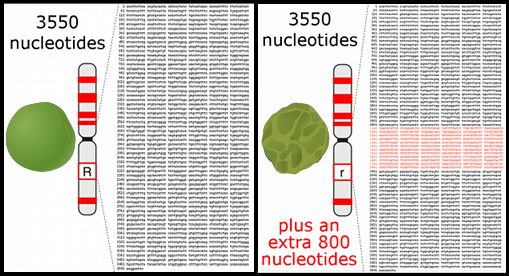
Instead, the presence of the r allele results in excess glucose that combines with fructose to produce sucrose. The additional sucrose means that homozygous rr pea seeds taste sweeter. Any pea plant that has at least one R allele will be able to make functional starch branching enzymes for use within pea plant seed cells. This explains why the R allele is considered dominant over the r allele.
Population Genetics
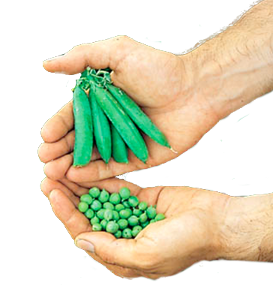 The evolution of species almost always occurs through natural selection. Natural selection is a process whereby some individuals with certain traits have a higher reproduction rate than individuals with other traits leading to a change of relative trait frequency within a population. Differences in reproduction rates often occur as a result of interactions between individuals and their environment. In some settings humans can act as a selecting force encouraging desirable traits to be fixated within a crop population while limiting undesirable traits.
The evolution of species almost always occurs through natural selection. Natural selection is a process whereby some individuals with certain traits have a higher reproduction rate than individuals with other traits leading to a change of relative trait frequency within a population. Differences in reproduction rates often occur as a result of interactions between individuals and their environment. In some settings humans can act as a selecting force encouraging desirable traits to be fixated within a crop population while limiting undesirable traits.
Artificial Selection of Recessive Phenotypes
The common field pea, Pisum sativum, has been an important crop in human civilizations since 10,000 BCE. Very early on in their domestication, farmers selected sweet wrinkled peas over round starchy peas for planting in their fields. Because wrinkled peas are recessive a farmer could conceivably plant and harvest an entire field of sweet peas in just one generation. Wrinkled pea seeds contain only the r allele; when a field of wrinkled peas are planted, 100% of the F1 generation will be wrinkled because no R alleles are present in the P1 generation. Conversely, if a farmer were trying to select for starchy peas it would be considerably harder. Since the round seed phenotype results from both the RR and the Rr genotypes, when a field of round peas is planted, both the R and r alleles are present (75% R and 25% r). The resulting F1 generation will be a mixture of RR, Rr and rr genotypes (ratio of 9:6:1). Through continual selective breeding over many generations it would be possible to fix the dominant trait within a population, but since the dominant allele masks the recessive allele fixation of the former takes longer.
Darwin used the example of artificial crop selection as an example to support his theory of natural selection.

